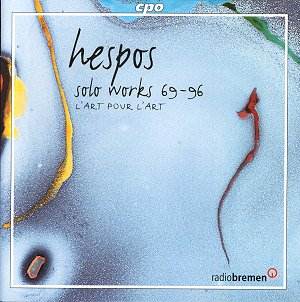Splash for double bass and percussion
may be the most satisfying piece here and, no doubt, the most
accessible for its jazzy influences, though it is far from simple,
easy or straightforward. It consists of some showy passages interspersed
either with rather long pauses or with nearly inaudible sections.
As most other pieces in this selection, it often calls for unusual
techniques with sounds sometimes verging on noise (somewhat alla
Lachenmann). Duma for alto flute runs the whole
gamut of modern flute playing, sometimes to the point of bluntly
achieving mere clichés. It is far too long for its own
good though there are some arresting moments of instrumental fancy.
Both Kitara for Spanish guitar (sic) and
Leija for harp are comparatively traditional (i.e.
by Hespos’s standards) though they too have their share of hectic
activity, sometimes of a percussive nature, alternating with almost
inaudible moments. Both pieces, as well as most other for that
matter, proceed in a somewhat clichéed stop-and-go pattern
that does not seem to lead anywhere. Monske, subtitled
Ritual for mobile timpani in C, is a five-minute display
of unusual noises seemingly drawn from timpani, resulting in things
sounding like rifle shots, skin scraping or someone drilling into
concrete, etc. Quite intractable, as far as I am concerned, for
you never really make-out which instrument might be playing. (I
suppose that this piece is the one calling for ‘special effects’
handled by Charly Plinke, as mentioned in the back cover.) Needlessly
ugly, I am afraid. Čang
for cymbal (!) solo rather sounds as a piece for cymbalon. It
again goes along plink-plonk amidst numerous pauses and eventually
amounting to very little of any musical interest (sorry to repeat
myself!). Pico for piccolo recorder, though shorter
than Duma, is quite similar in outlook and actual
sound world. The last piece –Z...( ) is also the
most enigmatic of all. First, its title (although the titles of
the other pieces do not tell you much about the piece or the music
either). Second, its subtitle mentioning a pianist though there
is no pianist in L’Art pour l’Art ensemble. Third, this is a rather
longish piece of noise making (including players’ coughing!),
probably with so-called special effects again, for the whole ensemble,
i.e. as far as I can judge by what I hear.
Hespos’s music often sets out to explore the
many possibilities of instrumental technique and often does so
with some extra-musical, theatrical devices as is quite clear
in all the solo pieces recorded here. It also makes generous use
of many unusual playing techniques resulting in some highly idiosyncratic
sound production. So, one’s reactions to this thought-provoking
selection of solo pieces will much depends on one’s appreciation
(or dislike) of any kind of musical theatre, and of the instrumental
histrionics often associated with it. Music such as this is likely
to fascinate or irritate. Hearing these carefully prepared and
dedicated performances, one may conclude that these pieces must
be fun to play. The question, however, is to know whether these
pieces are musically satisfying or not. I cannot help but feel
(and deplore) that much talent has been wasted for nothing here.
I am sorry not to be able to wax more enthusiastically
about this superbly played and well produced disc; but I am convinced
that some may find much to enjoy here.
Hubert Culot
